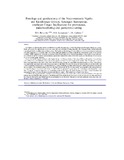Please use this identifier to cite or link to this item:
http://hdl.handle.net/10311/392| Title: | Petrology and geochemistry of the Neoproterozoic Nguba and Kundelungu Groups, Katangan Supergroup, southeast Congo: Implications for provenance, paleoweathering and geotectonic setting |
| Authors: | Batumike, M.J. Kampunzu, A.B. Cailteux, J.H. |
| Keywords: | Sediment provenance Geochemistry Proterozoic Katangan Supergroup Congo |
| Issue Date: | 2006 |
| Publisher: | Elsevier www.elsevier.com/locate/jafrearsci |
| Citation: | Batumike, M.J. et al (2006) Petrology and geochemistry of the Neoproterozoic Nguba and Kundelungu Groups, Katangan Supergroup, southeast Congo: Implications for provenance, paleoweathering and geotectonic setting, Journal of African Earth Sciences, Vol. 44, pp. 97–115 |
| Abstract: | The Nguba and Kundelungu Groups constitute the middle and upper parts of the Neoproterozoic Katangan Supergroup, respectively, and consist of conglomerates, sandstones, mudrocks and carbonates. During deposition, the Katangan basin received sediments originating from both northern and southern sources. The Nguba and Kundelungu Groups siliciclastic rocks have elemental abundances and ratios suggestive of a relatively felsic TTG source, although slightly more mafic compositions occur in the Nguba Group and the overlying ‘‘Petit Conglome´rat’’ Formation at the base of the Kundelungu Group. Modal compositions of the Nguba Group rocks indicate a basement uplift provenance, and geochemical parameters indicate the source of both the Nguba and Kundelungu Groups had an active continental margin character. Source area weathering was moderate in the Nguba Group. Low Chemical Index of Alteration (CIA) and Plagioclase Index of Alteration (PIA) indices and relatively uniform chemical compositions of the ‘‘Grand Conglome´rat’’ and the ‘‘Petit Conglome´rat’’ Formations lying respectively at the bases of the Nguba and Kundelungu Groups are compatible with deposition in a cool or frigid climate, and support their presumed petrographic based glaciogenic origin. High CIA and PIA indices in Upper Kalule rocks in the middle part of the Kundelungu Group point to the intensification of source weathering, possibly under tropical to subtropical climate under steady state conditions. Geochemical similarities between the Nguba Group and the ‘‘Petit Conglome´rat’’ are compatible with a change from an extensional setting to compression, with derivation of the ‘‘Petit Conglome´rat’’ by reworking of the underlying units during basin inversion. Change in provenance signatures and weathering indices in the Upper Kalule Formation may reflect reduced tectonism and resumption of supply of more weathered extrabasinal detritus, similar to that which fed the basal Roan Group. Overall the data suggest derivation mainly from pre-Katangan Proterozoic sources with continental arc characteristics. The adjacent Paleoproterozoic Ubendian Belt, particularly the Bangweulu block calcalkaline plutonic and volcanic province, is a suitable candidate as the source for the Nguba and Kundelungu Group sedimentary rocks. However, Mesoproterozoic and Archaean terrains have also contributed a minor component to the basin. |
| URI: | http://hdl.handle.net/10311/392 |
| ISSN: | 1464-343X |
| Appears in Collections: | Research articles (Dept of Geology) |
Files in This Item:
| File | Description | Size | Format | |
|---|---|---|---|---|
| Kampunzu2006Petrologyandgeochemistry.pdf | 1.55 MB | Adobe PDF |  View/Open |
Items in DSpace are protected by copyright, with all rights reserved, unless otherwise indicated.
